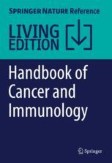Search
Search Results
-
Synergistic Combination Immunotherapy of Glioblastoma
Glioblastoma, a highly aggressive and malignant brain tumor classified as WHO grade IV, continues to pose a significant challenge despite the current...
-
A co-formulation of interferons alpha2b and gamma distinctively targets cell cycle in the glioblastoma-derived cell line U-87MG
BackgroundHeberFERON is a co-formulation of α2b and γ interferons, based on their synergism, which has shown its clinical superiority over individual...

-
VEGFR2 blockade inhibits glioblastoma cell proliferation by enhancing mitochondrial biogenesis
BackgroundGlioblastoma is an aggressive brain tumor linked to significant angiogenesis and poor prognosis. Anti-angiogenic therapies with vascular...

-
Suppressive Effect of Chemically Induced Hypoxia on Glioblastoma Cell Proliferation
Glioblastoma is a tumor characterized by pronounced hypoxia. Hypoxia produces diverse effects on tumor cells, and the results of experimental studies...
-
CRISPR-Cas9 identifies growth-related subtypes of glioblastoma with therapeutical significance through cell line knockdown
BackgroundGlioblastoma (GBM) is a type of highly malignant brain tumor that is known for its significant intratumoral heterogeneity, meaning that...

-
Let-7a-3p overexpression increases chemosensitivity to carmustine and synergistically promotes autophagy and suppresses cell survival in U87MG glioblastoma cancer cells
In terms of primary brain tumors, glioblastoma is one of the most aggressive and common brain tumors. The high resistance of glioblastoma to...

-
CD13 expression affects glioma patient survival and influences key functions of human glioblastoma cell lines in vitro
CD13 (APN) is an Alanyl-Aminopeptidase with diverse functions. The role of CD13 for gliomas is still unknown. In this study, data of glioma patients...

-
Targeting sphingolipid metabolism with the sphingosine kinase inhibitor SKI-II overcomes hypoxia-induced chemotherapy resistance in glioblastoma cells: effects on cell death, self-renewal, and invasion
BackgroundGlioblastoma patients commonly develop resistance to temozolomide chemotherapy. Hypoxia, which supports chemotherapy resistance, favors the...

-
Translocator protein (18kDA) (TSPO) marks mesenchymal glioblastoma cell populations characterized by elevated numbers of tumor-associated macrophages
TSPO is a promising novel tracer target for positron-emission tomography (PET) imaging of brain tumors. However, due to the heterogeneity of cell...

-
Aggressive migration in acidic pH of a glioblastoma cancer stem cell line in vitro is independent of ASIC and KCa3.1 ion channels, but involves phosphoinositide 3-kinase
The microenvironment of proliferative and aggressive tumours, such as the brain tumour glioblastoma multiforme (GBM), is often acidic, hypoxic, and...

-
TRIM25 promotes glioblastoma cell growth and invasion via regulation of the PRMT1/c-MYC pathway by targeting the splicing factor NONO
BackgroundUbiquitination plays an important role in proliferating and invasive characteristic of glioblastoma (GBM), similar to many other cancers....

-
KRAS is a molecular determinant of platinum responsiveness in glioblastoma
BackgroundKRAS is the undisputed champion of oncogenes, and despite its prominent role in oncogenesis as mutated gene, KRAS mutation appears...

-
Glioblastoma glycolytic signature predicts unfavorable prognosis, immunological heterogeneity, and ENO1 promotes microglia M2 polarization and cancer cell malignancy
Glioblastomas are the most malignant brain tumors, whose progress was promoted by aberrate aerobic glycolysis. The immune environment was highly...

-
Involvement of cell shape and lipid metabolism in glioblastoma resistance to temozolomide
Temozolomide (TMZ) has been used as standard-of-care for glioblastoma multiforme (GBM), but the resistance to TMZ develops quickly and frequently....

-
Selective cell cycle arrest in glioblastoma cell lines by quantum molecular resonance alone or in combination with temozolomide
BackgroundGlioblastoma is the most aggressive form of brain cancer, characterised by high proliferation rates and cell invasiveness. Despite advances...

-
Systematic in vitro analysis of therapy resistance in glioblastoma cell lines by integration of clonogenic survival data with multi-level molecular data
Despite intensive basic scientific, translational, and clinical efforts in the last decades, glioblastoma remains a devastating disease with a highly...

-
Immune cell infiltration and drug response in glioblastoma multiforme: insights from oxidative stress-related genes
BackgroundGBM, also known as glioblastoma multiforme, is the most prevalent and lethal type of brain cancer. The cell proliferation, invasion,...

-
Association Between Diverse Cell Death Patterns Related Gene Signature and Prognosis, Drug Sensitivity, and Immune Microenvironment in Glioblastoma
Glioblastoma (GBM) is the most invasive type of glioma and is difficult to treat. Diverse programmed cell death (PCD) patterns have a significant...

-
Nitric Oxide Synthase Inhibition Prevents Cell Proliferation in Glioblastoma
Glioblastoma multiforme (GBM) is a prevalent and aggressive primary brain tumor, presenting substantial treatment challenges and high relapse rates....

-
Tumor Treating Fields (TTFields) combined with the drug repurposing approach CUSP9v3 induce metabolic reprogramming and synergistic anti-glioblastoma activity in vitro
BackgroundGlioblastoma represents a brain tumor with a notoriously poor prognosis. First-line therapy may include adjunctive Tumor Treating Fields...

